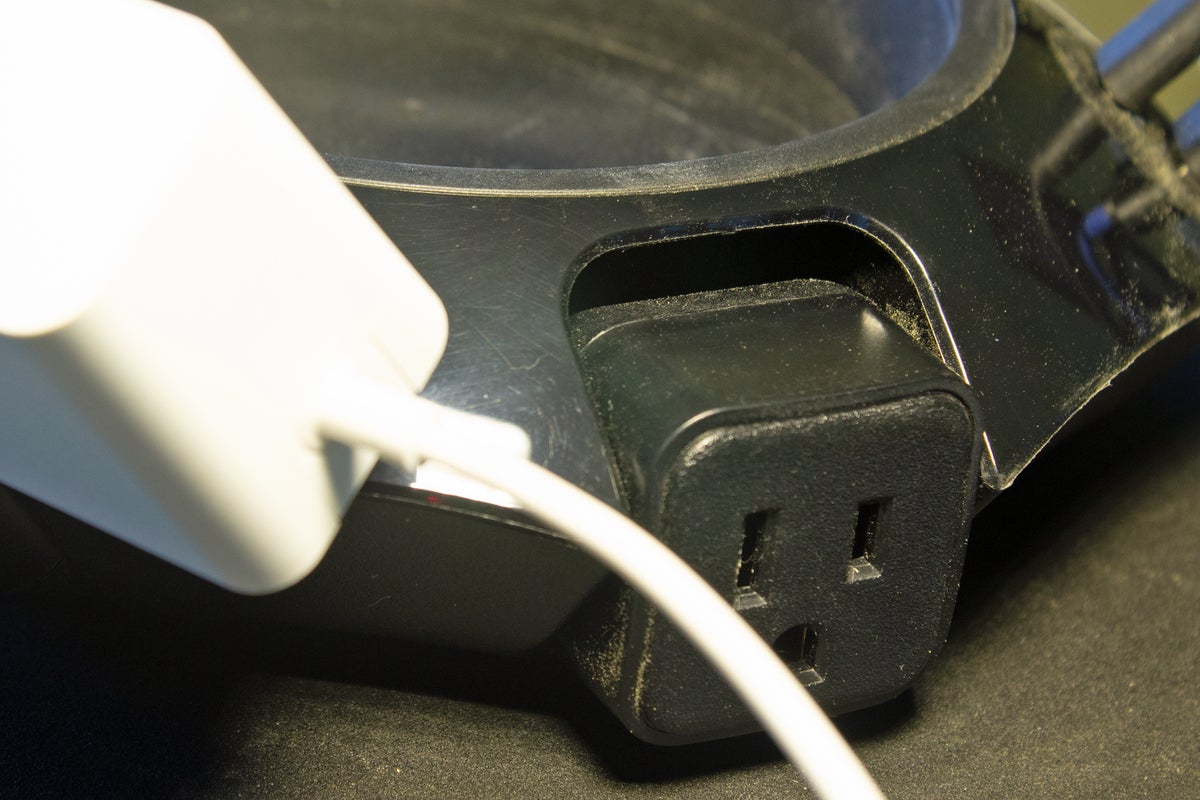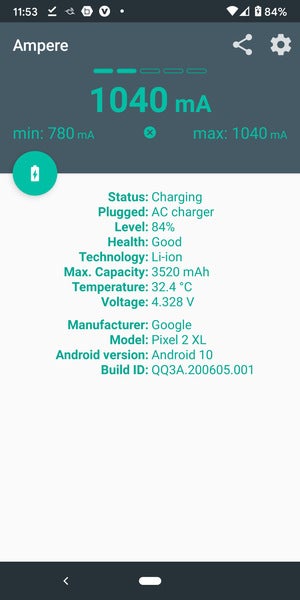
[ad_1]
The Accell Power Dot takes some design cues from the company’s earlier Poweramid surge protector (now street priced at $20), adds a USB-C charging port, and scoops out its middle to make a recessed hollow for a smart speaker. On the downside, it has two fewer outlets than the Poweramid and costs twice as much.
Providing four outlets in an 8-inch footprint instead of the Poweramid’s six allowed the Power Dot’s designers to space the outlets further apart. With about 1.75 inches between each of them, you’ll have no problem plugging in oversized wall warts. I was able to plug the three-inch-wide, right-angled AC adapter for a 10-inch Lenovo Smart Display into any of the four outlets without blocking any other outlet or the two sets of USB charging ports.
This review is part of TechHive’s coverage of the best surge protectors, where you’ll find reviews of competing products, plus a buyer’s guide to the features you should consider when shopping.
Removing a 5-inch plastic plate from the center of the Power Dot exposes a recessed cavity designed to accommodate a round smart speaker such as an Amazon Echo Dot or a Google Nest Mini. You might think the removable plate is a waste of plastic, but (as I discovered) it makes the perfect platform to host an Echo Spot smart display. If you don’t have a smart speaker, you could use that cup to wrangle paperclips, spare change, or other small objects. Resist the temptation to use that hollow as a drink coaster, though; you wouldn’t want to spill liquid into those outlets.
 Michael Brown / IDG
Michael Brown / IDGThe round form factor and the widely spaced outlets enable the Accell Power Dot to accommodate even oversized AC adapters without blocking adjacent outlets.
The AC outlets are angled up in their default position, making it easier to plug power adapters into them, but they also pivot down to a 90-degree angle if you find that makes it easier to plug in regular power cords. Unfortunately, the Power Dot’s pivoting outlets aren’t all that useful, and it takes a lot of effort to move them to boot. If that design feature is responsible for making the Power Dot so expensive, it was a mistake.
The Power Dot provides 1,080 joules of protection across its four outlets, with 400 volts of maximum clamping voltage on each leg (line-neutral, line-ground, and ground-neutral). A “protection” LED will glow until the unit’s MOVs have burned out, but the LED’s location above the on/off switch and beneath the top surface makes it difficult to see.
 Michael Brown / IDG
Michael Brown / IDGThe Power Dot’s four outlets pivot, but it takes a lot of force to move them.
The position of the LED is especially problematic if you arrange the Power Dot so that its 8-foot power cord goes straight to the back of your desk, as that puts the switch on the right-hand side and out of your line of sight. (Should you find that cord too short, there’s another model with a 16-foot power cord that’s priced at $60.) The LED was tough to spot even when I arranged the device so the switch was facing me—at least when I was standing (since I’ve started using an Evodesk XE Pro sit/stand desk, I rarely sit while working). The indicator LED was a little more visible when I was seated.
USB charging ports
 Michael Brown / IDG
Michael Brown / IDGWhile Accell says its Power Dot doesn’t support the USB Power Delivery standard, it did prove capable of rapidly charging my Pixel 2 XL when I plugged it in to its USB-C port.
On the top surface of the Power Dot and flanking the on/off switch are a total of four USB charging ports, which share 5 volts, 4.8 amps and 24 watts. On the left side of the switch, you’ll find one USB-C port that delivers a maximum of 5 volts, 3 amps, and 15 watts.
The first of three USB Type-A ports sits beneath the USB-C port, with the other two positioned on the right-hand side of the power switch. All three of the USB-A ports can deliver up to 5 volts, 2.4 amps, and 12 watts. If a device plugged into the USB-C port is pulling the maximum of 3 amps, the three USB-A ports must divvy up the remaining 1.8 amps and vice versa. As Access explained the prioritization: “The hungrier the device, the more power it will get.”
All four ports are sufficiently spaced to accommodate oversized plugs. Accell says the Power Dot’s USB-C port does not support the USB Power Delivery standard, but my Pixel 2 XL nonetheless reported that it was charging rapidly when I plugged it in (the app Ampere reported the phone as drawing a minimum of 780mA and a maximum of 1,040mA).
Verdict
You’ll encounter plenty of less-expensive surge protectors that can accommodate a lot more devices when you go shopping, but the Power Dot’s round form factor and its ability to host a small smart speaker do render it unique in a sea of longitudinal power strips. Whether that makes it worth an extra 10-spot for half the outlets you’ll get with its more conventional competitors is up to you.
[ad_2]
Source link